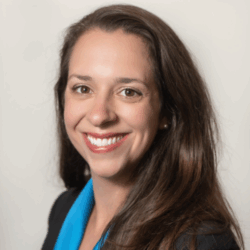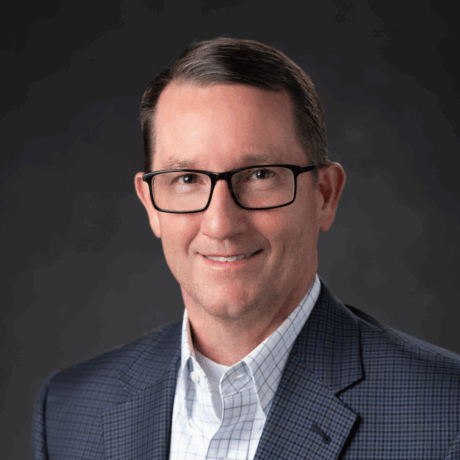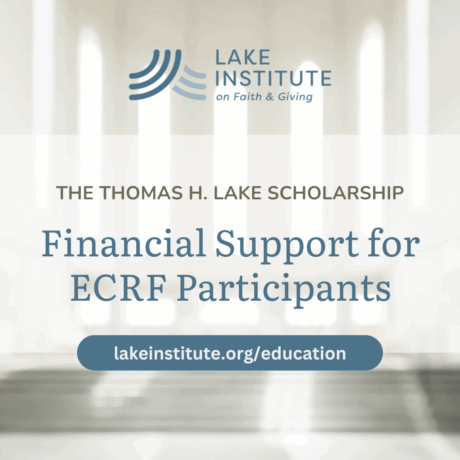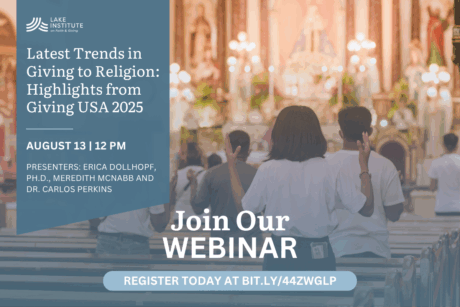Giving USA 2025: Trends in Religious Giving
Giving USA 2025: Trends in Religious Giving
By Erica Dollhopf, Ph.D., Associate Director of Research
 The 2025 edition of Giving USA provides updated information on current trends across giving sectors, including giving to religious organizations. Researched and written by the Lilly Family School of Philanthropy at IU Indianapolis and published by the Giving USA Foundation, the report has provided comprehensive information on charitable giving in the U.S. for the past 40 years. Religion is one of the major subsectors studied in Giving USA, which includes congregations, denominations, religious media, and missionary societies, though it excludes religiously motivated or inspired organizations that are operating in a different sector.
The 2025 edition of Giving USA provides updated information on current trends across giving sectors, including giving to religious organizations. Researched and written by the Lilly Family School of Philanthropy at IU Indianapolis and published by the Giving USA Foundation, the report has provided comprehensive information on charitable giving in the U.S. for the past 40 years. Religion is one of the major subsectors studied in Giving USA, which includes congregations, denominations, religious media, and missionary societies, though it excludes religiously motivated or inspired organizations that are operating in a different sector.
The study found that, overall, giving in 2024 increased 6.3% (3.3% adjusted for inflation). All nine major subsectors of charitable giving saw an increase when measured in current dollars, but when adjusted for inflation, giving to religion decreased slightly and was the only sector to see a decline. Giving to religion in 2024 was estimated at $146.54 billion, representing a 1.9% increase that translated to a 1% decrease when adjusted for inflation. While religious organizations continue to receive the most giving across subsectors, the proportion of giving directed toward religion has continued to gradually decline. While religion had 34% of total giving in 2011, it had only 23% in 2024. One of the factors underlying this trend is the slower growth of religious giving relative to other sectors. For instance, total giving from 2022-2024 increased 8.7% while giving to religion only increased 2.8%.
Several factors may be influencing these trends. First, the rates of identification with and participation in religious groups have gradually declined in the U.S., as noted across several studies. In one example, a 2024 PRRI study found that the proportion of U.S. adults identifying as religiously unaffiliated grew from 21% to 26% between 2013 and 2023, while all other major religious categories declined. In another example, Gallup found that Americans less frequently identify as a member of a religious congregation, dropping from 70% in 1999 to 45% in 2023 – notably the rate was 73% in 1937, so the steepest declines have been more recent.
Additionally, religiously involved people are giving less in some cases. The 2024 annual report from MortarStone found in a survey of churches that median giving per household declined from $910 in 2021 to $600 in 2024; however the median increased by 47% in the same period among the top 1% of givers. Even when congregations’ income is increasing, the increases may not be enough to offset inflation. The Finances and Faith report from the Faith Communities Today (FACT) and Exploring the Pandemic Impact on Congregations (EPIC) surveys found that while median congregational income increased from $150,000 to $165,000 since 2010, congregational income would need to have reached $209,603 in 2023 to stay on pace with inflation.
Many of these findings point to challenges, but there are also hopeful shifts in the religious giving landscape. The Giving USA Foundation’s Giving by Generations Report found that Millennial giving per household, which increased 22% in 2024, has surpassed Gen X giving. In addition, Millennials report attending religious services more frequently than Gen X. This may ultimately result in the younger Millennials giving more generously to religious organizations than the older generation. Also, some congregations experiencing membership decline alongside increased building costs are finding innovative ways to be engaged with their communities and leverage un- or under-utilized spaces through affordable housing projects.
Looking toward the future, religious organizations may be able to pursue strategies to increase giving and continue to find creative ways to transform buildings, engage in their changing communities, reimagine congregational financial models, and possibly open new avenues for giving. The Finances and Faith report found that congregations offering online giving generally have higher incomes that do not offer online giving, and greater emphases on online giving in a congregation also tends to correspond with higher levels of online giving. Congregations offering online giving rose from one-third to over two-thirds between 2015 and 2023; if congregations can continue to expand electronic and online giving options, they may also be able to experience higher levels of giving among their participants.
Also, as congregations pursue innovative strategies around their buildings and community presence, through establishing partnerships and new sources of revenue, they may find ways to flourish even in the midst of general declines in religious identification and participation. While the religious giving sector is a smaller slice of the overall giving economy than it had been more than a decade ago, it remains the largest recipient of donations and religious giving continues to be a philanthropic priority for many individuals in the U.S. While the sector will continue to change over time, it remains highly important and a crucial area for future research.
The Power of Good Data
By Rickey Letson, Vice President of Client Services at Missional Business Services

As someone who deeply values the latest statistical information and feels honored to work with faith communities, I want to be someone who uses the newest research with the utmost care. To do so, I constantly try to balance two ideas that serve as good guardrails for me in this area.
First, sharing reliable, current research on the actual behavior of people of faith is always an important way to gently correct and improve ideas that are often based on emotions and feelings but rarely grounded in facts. It is very common for laypeople and professionals in religious organizations to rely on perceptions that, over time, have been accepted as truth. When research and up-to-date statistics allow us to challenge and correct these perceptions, it often provides an enlightening opportunity for everyone involved to become more informed and think more accurately. When new research makes this possible, it is a positive achievement.
Second, and on the other hand, it is always important to recognize that research and data often illustrate typical behavior and practice but never fully explain unique situations, contexts, and environments. Some situations defy all the statistics. This means that when we present the latest findings, we must be quick to admit that, as helpful as they are, these new reports may not capture the full picture of our small segment of the population or issue.
Having served congregations for over 30 years, I have seen both sides of this equation firsthand. I have certainly participated in many meetings with wonderful leaders where passionate perspectives are shared, often without solid factual backing. In such situations, it is always helpful to have strong, reliable information readily available that can be shared graciously to correct misguided views and serve as a teaching tool for the entire group. At the same time, I have also relied on solid statistics that illustrate how things generally work, only to find that my current situation does not always match the general, fact-based perspective. These moments serve as a reminder that no matter how many statistics we have, they can’t account for every individual experience or situation.
Ultimately, I have come to realize that utilizing research wisely and thoughtfully is a crucial aspect of religious work that grounds us all. At the same time, our unique context is also a reality that can never be fully understood or explained by the latest and best research available. When I can hold these two truths in tension with each other, I believe I am best prepared to utilize the research at my disposal wisely and effectively.
Rickey Letson is the Vice President of Client Services for Missional Business Services (MBS). MBS supports congregations and religious nonprofits across the United States, with a particular focus on providing outsourced bookkeeping, accounting, payroll, and financial consulting services. Rickey and his family live in Madison, Alabama.
Explore ECRF Scholarship Opportunities
 Thanks to the support of generous Lake Institute donors, we are able to offer partial scholarships for our Executive Certificate in Religious Fundraising course through the Thomas H. Lake Scholarship fund.
Thanks to the support of generous Lake Institute donors, we are able to offer partial scholarships for our Executive Certificate in Religious Fundraising course through the Thomas H. Lake Scholarship fund.
The 2025 summer scholarship application process is now open! Due to website issues last month, we will keep the application open through the end of July.
Subscribe
Insights is a bi-weekly e-newsletter for the religious community and fundraisers of faith-based organizations that provides:
- Reflections on important developments in the field of faith and giving
- Recommended books, studies and articles
- Upcoming Lake Institute events


 Join our webinar on August 13th at 12 PM ET as our team presents highlights from the 2025 Giving USA report and discuss the latest trends in religious giving.
Join our webinar on August 13th at 12 PM ET as our team presents highlights from the 2025 Giving USA report and discuss the latest trends in religious giving.